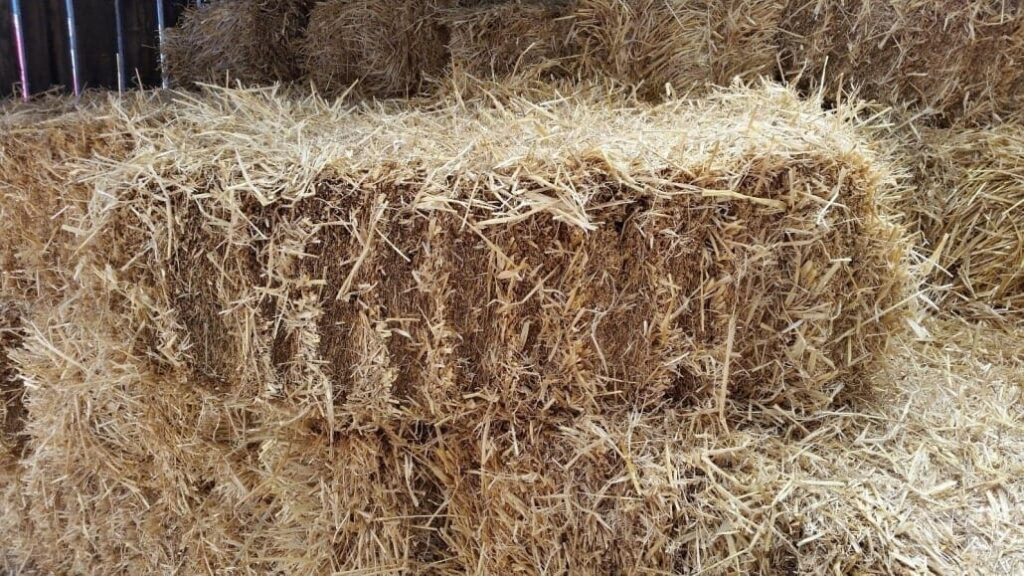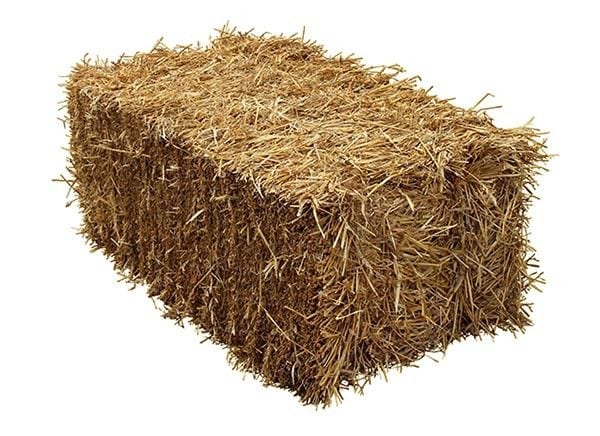Fleet Farm Barley straw bales of feed quality. Locally produced here in Lancashire to high-quality standards. Each highly compressed straw bale is approximately 100cm x 50cm x 40cm, weighing in at around 18kg.
Fleet Farm is based in Fleetwood, Lancashire, UK. It is a working farm with a herd of cattle, plus stables with over 50 horses in residence. Over the years a large Equestrian Tack Shop has grown, providing Rider Wear, Horse Wear, Horse Tack, and much more.
Barley Straw Bales are used for horses and other large animals (we regularly supply to llamas, pigs, alpacas, rheas, goats, pot-bellied pigs, and donkeys!), as well as for dogs, rabbits, chickens, guinea pigs, tortoises, and other small pets.
100% Natural Bedding
Our Barley Straw Bales are 100% natural and environmentally friendly. Natural straw bedding is the best you can get for your pets. As this is of feed quality, if your pets choose to eat it, we won’t be surprised.
Where Else can Our Straw Bales Be Used?
Ideal as garden seating for that rustic look! We have supplied these to schools, live music venues, and The British Army – who have all used them for temporary seating.
Also used in garden ponds to reduce algae growth as the composition of our barley straw combats algae, and by keen gardeners to protect plants against frost through the winter months.
Our straw bales are packaged in a cardboard box for delivery. Many of our customers keep the box and take the straw out as they need it, by simply opening the top of the box and cutting the strings around the straw. This keeps mess and loose straw to a minimum!
Bulk orders are welcome, we can also ship out on pallets. Call for details on 01253 870558. We always have thousands of fresh straw bales in stock.
Our Hay Bales are also popular, especially for smaller pets, and very cost-effective as an 18kg bale (even with next-day delivery charges on top).
Standard delivery is via DPD next-working-day to mainland UK. Delivery outside of mainland UK may incur an additional cost and take longer. Please call us for a delivery price at cost.
Uses in Straw Bale Construction
If you are using our Straw Bales for Straw Bale Construction, please call us first as we’ll need to organise delivery via pallets to construction sites. Our price per bale will be very competitive for you!
Straw-bale construction is a type of construction that uses straw bales (typically barley, wheat, rice, rye, and oat straw) as structural elements, insulation, or both. Natural building or “brown” construction projects frequently employ this construction approach.
According to research, straw-bale construction is a sustainable building option in terms of both resources and energy required for heating and cooling.
Straw-bale construction has several advantages over traditional building material, including its renewable nature, low cost, easy availability, natural fire resistance, load-bearing capability, the fact that it is environmentally friendly, and its excellent insulating value. Fancy a straw bale house?
Barley Straw for Controlling Pond Algae
One of the most common issues with ponds in the UK is excessive algae growth. Mechanical and chemical control measures are not always effective or cost-effective. To realize the dream of crystal clear water in your garden pond, read on…
Barley straw has grown more popular in recent years as an alternative approach for managing excessive algae growth. Dr. Jonathan Newman of the Centre for Aquatic Plant Management in the United Kingdom has conducted substantial research on this strategy.
Barley straw has proven to be an effective algae control method in UK ponds when applied at the right time and rate. It is 100% natural, environmentally friendly and contains none of the toxins associated with chemicals!
How Do Barley Straw Bales Control Algae?
Barley straw does not eliminate current algae, but it does prevent new algae growth. Although the specific mechanism is unknown, it appears that when barley straw is exposed to sunlight and oxygen, it creates a chemical that inhibits algae growth.
Other aquatic plants’ development is unaffected by barley straw. In reality, because algae are no longer present to compete with aquatic plants, aquatic plant growth has risen in some cases after barley straw treatments.
When should you use it?
When used early in the year, before the appearance of algae, barley straw is most beneficial (autumn through early spring). It may take six to eight weeks for the straw to begin producing the active compounds that prevent algae development when used in cold water (below 50°F).
If the straw is submerged in warm water (over 70°F), it can work in as little as one to two weeks. Barley straw, in any case, is beneficial for around six months following application.
How much straw do you need?
The most usual application is two to three bales per acre of pond surface area (or about 10 to 25 grams of straw per square metre of pond area). The pond’s depth of water is unimportant. Two or three times this suggested dose may be required for the initial treatment in ponds that are regularly muddy or have a history of high algae development.
Overdosing the pond with barley straw, on the other hand, may result in fish deaths since the straw deoxygenates the water as it decays. This is particularly problematic if the pond has overdosed with straw during a protracted period of warm weather.
What is the best way to use the straw?
When used loosely in cages or nets, the straw is most effective. The straw packets should be anchored to the pond’s bottom, but a float should be provided to maintain the straw toward the pond’s surface, where sunshine and oxygen are more abundant.
Apply the straw to numerous spots around the pond, particularly near the water source if the pond is fed by a spring or stream. Modest nets or nylon stockings can be used to hold the small amounts of straw required in a small pond.
Barley Straw Bales For Gardening
Barley Straw Bales can be used in composting
Composting requires the use of both nitrogen-rich (green) and carbon-rich (brown) components. Getting the proportions between these two types of material just right can go a long way toward making your composting system a success.
Straw is a fantastic (brown) carbon-rich substance. It can assist maintain things in balance when added to a larger scale composting system alongside nitrogen-rich materials like fruit and vegetable scraps and grass clippings, or fresh manures. It will keep the heap or bin aerated, preventing anaerobic conditions. It will also guarantee that the compost you make has a decent texture.
Straw can be used to create new growing areas
Straw can also be incorporated into the construction of new growing spaces. Composting does not need to be done in a separate heap, bin, or composting system. You can also compost on-site, allowing things to decompose in the area where your plants will thrive.
In a ‘lasagna bed,’ straw can be used to generate carbon-rich layers. In a ‘no dig’ garden, a lasagna bed is one approach for creating new growth zones. No-dig gardening is leaving the soil as undisturbed as possible rather than removing turf and digging new beds. Cover the turf and add layers of organic material to compost in place to create a growing environment. Straw is only one of the various materials that may be used to construct a bed like this.
Straw can be used as a mulch in garden beds
Straw can also be used to mulch existing garden beds. Straw is an excellent mulching material. It may be able to:
- Protect the soil from nutrient loss and erosion.
- Assist in the retention of soil moisture.
- Assist with weed control.
- Keep fruits off the soil surface to keep them from decaying and disease outbreaks at bay. (For example, it’s frequently used around strawberry plants, squash, and pumpkins.)
- In the winter, straw keeps the soil from freezing and the plants warm.
Straw can be used as insulation
As previously indicated, straw can be used as a thick mulch to keep plants warm in the winter and avoid soil freezing and frost damage.
Straw can also be used as an insulator in a variety of different applications. Straw is good for retaining heat and can be used in and around flower beds and containers.
It can also be used in a compost heap to keep the heat in. A thick coating of straw applied to a compost heap or around a compost bin can hasten decomposition and be used to create a hot composting system. The straw will not only aid in heat retention. As it begins to decompose, it will also produce heat.
As insulation, loose straw could be put into cavities in a greenhouse or polytunnel, shed, chicken coop, or other garden construction to keep the space cooler in the summer and warmer in the winter.
Straw bales can be used as garden beds
So far, we’ve spoken about how to use loose straw. But now let’s talk about how to use straw bales. Straw bales can also be quite beneficial in your garden.
Straw bale gardening is one approach to making use of straw bales. Straw is not employed as a component in your growth regions in straw bale gardening. Rather, the bales serve as raised beds in and of themselves.
Your plants will have enough nutrients as the straw decomposes, and it has even been claimed that plants planted in straw bales can be up to 25% more productive than those planted in medium-grade soil. Because of the heat generated by the decomposition below, you may plant earlier in the year and lengthen the growing season than you could in the ground.
- Soak the bales in water to help them disintegrate. (This can be accomplished simply by keeping it wet for about a month.)
- Fill the drenched bale with a good amount of nitrogen-rich fertilizer. (A nettle or grass clipping feed is great.)
- After a month or so, you’ll be able to tell if it’s working by the temperature and fragrance of the bale.
- Cover the top of the bale with a thin layer of excellent quality compost, about an inch or two thick.
- Your straw bale garden is now ready to be planted.
Edging a Straw Bale Bed
Instead of utilising the straw bales as beds, consider using them as bed edging. Straw bales can be used as a temporary edging for a variety of growth situations. They will degrade over time, but they will protect, insulate, and contain the materials behind them in the interim.
You might also think about rendering the bales. This will allow you to make garden bed edging that will stay longer. A clay render may be acceptable for outdoor application in drier temperature zones. In wetter climates, a lime render could be excellent for exterior application. If you add wood to your rendered straw bale edging, they may also be used as bench seating around the margins of your beds.
Make a Garden Structure Out of Straw Bales
Straw bales can also be used to construct a variety of garden structures. Straw bale construction is an environmentally beneficial and long-lasting building technology. It can be used to build houses, but it can also be used to manufacture a wide variety of garden structures and buildings. Straw bales, for example, could be used to make:
- Garden fences
- A summer home or other garden structure for enjoyment
- Utility structures or storage sheds
- Straw bale chicken coops or other animal housing
- The foundation walls of a greenhouse or polytunnel
 Check out one of the finest Hotels in Southern Africa for your next vacation!
Check out one of the finest Hotels in Southern Africa for your next vacation!
The post Barley Straw Bales and their many uses – 100% Natural appeared first on https://richcitations.org
The post Barley Straw Bales and their many uses – 100% Natural appeared first on https://wookicentral.com
The post Barley Straw Bales and their many uses – 100% Natural appeared first on https://gqcentral.co.uk


Comments are closed